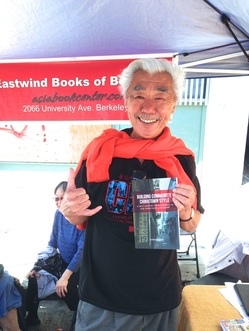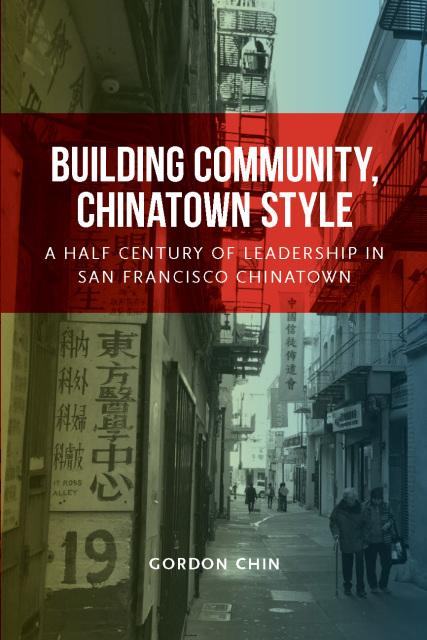- Asian American Studies
- >
- Chinese American Studies
- >
- Building Community, Chinatown Style: A Half Century of Leadership in San Francisco
Building Community, Chinatown Style: A Half Century of Leadership in San Francisco
SKU:
9780996418607
$24.95
$24.95
Unavailable
per item
Author: Gordon Chin
ISBN: 9780996418607
Publisher: Friends of CCDC
Publication Date: 2015
Binding: Paperback
Condition: New
ISBN: 9780996418607
Publisher: Friends of CCDC
Publication Date: 2015
Binding: Paperback
Condition: New

September 19, 2015. Sat, 3-5pm.
Gordon Chin talks about
Building Community, Chinatown Style: A Half Century of Leadership in San Francisco Chinatown
at Eastwind Books of Berkeley, 2066 University Ave.
A book written by Gordon Chin, founding member of the Chinatown Community Development Center of San Francisco. Provides a firsthand view on how to produce meaningful and positive social change from the grassroots. Packed with local information, history, people's stories about resistance and improving their lives.
Co-sponsored by Eastwind Books of Berkeley, Oakland Asian Cultural Center, National CAPACD, and the UC Berkeley Asian American and Asian Disapora Studies Program
Gordon Chin talks about
Building Community, Chinatown Style: A Half Century of Leadership in San Francisco Chinatown
at Eastwind Books of Berkeley, 2066 University Ave.
A book written by Gordon Chin, founding member of the Chinatown Community Development Center of San Francisco. Provides a firsthand view on how to produce meaningful and positive social change from the grassroots. Packed with local information, history, people's stories about resistance and improving their lives.
Co-sponsored by Eastwind Books of Berkeley, Oakland Asian Cultural Center, National CAPACD, and the UC Berkeley Asian American and Asian Disapora Studies Program
More about the book:
Contents
Introduction
Prologue
Section One: Convergence
The Asian American and Community Development Movements in San Francisco, 1968–1977
Chapter 1: Ten Years That Woke Up Chinatown
Chapter 4: Saving Chinese Playground
Chapter 2: Fighting for San Francisco Neighborhoods
Chapter 3: The Fall of the I Hotel
Chapter 4: Saving Chinese Playground
Chapter 5: The Mei Lun Yuen Affordable Housing Project 55
Chapter 6: Those Chinese Bus Drivers
Section Two: Preservation
Fighting for Chinatown’s Land and People, History and Identity, 1977–1987
Chapter 7: Starting an Organization
Chapter 8: Becoming Housing Developers 103 Chapter 9: The Ping Yuen Rent Strike
Chapter 10: Saving Residential Hotels
Chapter 11: Chinatown Alleyways
Chapter 12: Chinatown Land Use Wars 141 Chapter 13: Rezoning Chinatown
Section Three: Revitalization Planning for Chinatown and Its Place in San Francisco, 1988–1999
Chapter 14: The Loma Prieta Earthquake
Chapter 15: Transportation Aftershocks
Chapter 16: Preserving Housing, Preserving Neighborhoods 193 Chapter 17: The Broadway Corridor
Chapter 18: Building Community, Chinatown Style
Section Four: Transitions
To New Visions and New Leadership for Chinatown, 2000–2012
Chapter 19: The Rise of the I Hotel
Chapter 20: The International Hotel Block
Chapter 21: The Central Subway
Chapter 22: The New Era of Affordable Housing in San Francisco
Chapter 23: Who Can Afford to Live in San Francisco?
Section Five: Movements
Politics and Leadership, Chinatowns and the Asian American Movement
Chapter 24: From Community Leadership to Political Leadership
Chapter 25: Chinatown USA
Chapter 26: The National Asian American Community Development Movement
Chapter 27: You Can Never Have Enough Leadership … or Hawaiian Shirts
Epilogue
Book Review
When Gordon Chin and fellow activists formed the Chinatown Community Development Center (CCDC) on April 1, 1977, San Francisco’s Chinatown was at risk. Powerful interests were out to transform the neighborhood, and that August saw the mass eviction (and later demolition) of the International Hotel on Chinatown’s border.
Chin’s story reveals CCDC as a remarkable incubator for young activists. Those that passed through CCDC on route to other work included Howard Gong, Daryl Higashi, Brad Paul, David Prowler, Sue Lee, Melanie Young, Ilene Dick, D6 Supervisor Jane Kim, and many others. Chin amply credits the wonderful Enid Lim, whose Chinatown work was joined by her undercover efforts to help us stop tourist conversions in the Tenderloin.
While generously crediting others, Chin downplays his own central role. He describes his presence in Chinatown and citywide housing campaigns without noting that he typically chaired key meetings. Nor does he mention that people looked to him for strategic advice. Instead of promoting himself Chin believed in empowering his staff, which is why CCDC has attracted and retained so many talented activists through this day.
Gordon Chin’s new book offers the true history of how Chinatown survived as a low-income neighborhood. It wasn’t luck or good fortune—it was through CCDC’s organizing, community outreach, and coalition building, all of which created a model for community building that other neighborhoods can follow.
- Review by Randy Shaw
http://www.beyondchron.org/gordon-chins-new-book-touts-community-building-in-chinatown/
Contents
Introduction
Prologue
Section One: Convergence
The Asian American and Community Development Movements in San Francisco, 1968–1977
Chapter 1: Ten Years That Woke Up Chinatown
Chapter 4: Saving Chinese Playground
Chapter 2: Fighting for San Francisco Neighborhoods
Chapter 3: The Fall of the I Hotel
Chapter 4: Saving Chinese Playground
Chapter 5: The Mei Lun Yuen Affordable Housing Project 55
Chapter 6: Those Chinese Bus Drivers
Section Two: Preservation
Fighting for Chinatown’s Land and People, History and Identity, 1977–1987
Chapter 7: Starting an Organization
Chapter 8: Becoming Housing Developers 103 Chapter 9: The Ping Yuen Rent Strike
Chapter 10: Saving Residential Hotels
Chapter 11: Chinatown Alleyways
Chapter 12: Chinatown Land Use Wars 141 Chapter 13: Rezoning Chinatown
Section Three: Revitalization Planning for Chinatown and Its Place in San Francisco, 1988–1999
Chapter 14: The Loma Prieta Earthquake
Chapter 15: Transportation Aftershocks
Chapter 16: Preserving Housing, Preserving Neighborhoods 193 Chapter 17: The Broadway Corridor
Chapter 18: Building Community, Chinatown Style
Section Four: Transitions
To New Visions and New Leadership for Chinatown, 2000–2012
Chapter 19: The Rise of the I Hotel
Chapter 20: The International Hotel Block
Chapter 21: The Central Subway
Chapter 22: The New Era of Affordable Housing in San Francisco
Chapter 23: Who Can Afford to Live in San Francisco?
Section Five: Movements
Politics and Leadership, Chinatowns and the Asian American Movement
Chapter 24: From Community Leadership to Political Leadership
Chapter 25: Chinatown USA
Chapter 26: The National Asian American Community Development Movement
Chapter 27: You Can Never Have Enough Leadership … or Hawaiian Shirts
Epilogue
Book Review
When Gordon Chin and fellow activists formed the Chinatown Community Development Center (CCDC) on April 1, 1977, San Francisco’s Chinatown was at risk. Powerful interests were out to transform the neighborhood, and that August saw the mass eviction (and later demolition) of the International Hotel on Chinatown’s border.
Chin’s story reveals CCDC as a remarkable incubator for young activists. Those that passed through CCDC on route to other work included Howard Gong, Daryl Higashi, Brad Paul, David Prowler, Sue Lee, Melanie Young, Ilene Dick, D6 Supervisor Jane Kim, and many others. Chin amply credits the wonderful Enid Lim, whose Chinatown work was joined by her undercover efforts to help us stop tourist conversions in the Tenderloin.
While generously crediting others, Chin downplays his own central role. He describes his presence in Chinatown and citywide housing campaigns without noting that he typically chaired key meetings. Nor does he mention that people looked to him for strategic advice. Instead of promoting himself Chin believed in empowering his staff, which is why CCDC has attracted and retained so many talented activists through this day.
Gordon Chin’s new book offers the true history of how Chinatown survived as a low-income neighborhood. It wasn’t luck or good fortune—it was through CCDC’s organizing, community outreach, and coalition building, all of which created a model for community building that other neighborhoods can follow.
- Review by Randy Shaw
http://www.beyondchron.org/gordon-chins-new-book-touts-community-building-in-chinatown/

